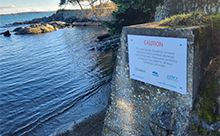Stormwater and Wastewater Overflows: Why Do They Still Happen?
Overflows can happen when heavy rainfall overloads the sewer system. Heavy rainfall and capacity limitations in the conveyance (pipe) systems can trigger overflows at emergency outfall locations.
Overflows can also occur due to mechanical failure or operational issues. The system is designed this way to prevent major damage to infrastructure and surrounding shoreline.
What are sewer overflows?
A sewage or sewer overflow refers to a short-term event where some amount of sewage leaves the normal wastewater collection and treatment process and discharges to the local environment instead.
Flows from combined stormwater and wastewater collection systems increase significantly during rain events. During these events, screened flows may bypass the pumpstations and discharge through outfalls.
How will I know when there has been an overflow?
 Beaches between Ripon Road and Cattle Point in Oak Bay have permanent signage in place advising the public to avoid entering the water along the affected shorelines for 48 hours following a rain event, as the combined stormwater and wastewater discharges may pose a health risk.
Beaches between Ripon Road and Cattle Point in Oak Bay have permanent signage in place advising the public to avoid entering the water along the affected shorelines for 48 hours following a rain event, as the combined stormwater and wastewater discharges may pose a health risk.
Overflows that occur at other locations or due to mechanical failure will be communicated on this page via Alerts and Notices and on Twitter @crd_bc.
What is being done to prevent overflows?
The Trent Forcemain and Arbutus Attenuation Tank (part of the Wastewater Treatment Project) were built to increase the capacity of the conveyance system which will significantly reduce the frequency and duration of overflows during periods of heavy rain and should eliminate all unscreened overflows.
Locations that continue to receive combined stormwater and wastewater flows, such as the Humber Pump Station and Rutland Pump Station in Oak Bay, will continue to discharge screened and heavily diluted overflows during heavy rain storms on an annual basis leading up to 2030, when member municipalities fully implement reduction efforts including infrastructure upgrades.
The CRD will continue to work with core area municipalities under our liquid waste management plan to continue to reduce the duration and frequency of overflows as much as possible. The District of Oak Bay continues to work on the Uplands combined sewer separation project which will ultimately address the pumpstation bypass issue for Humber Road and Rutland Road Pumpstations.
What is the difference between sanitary and combined sewers?
Sanitary sewers collect wastewater that is put down a toilet or drain and carry it to wastewater treatment plants. They are separated from stormwater. Combined sewers carry both wastewater and stormwater in a single pipe. Combined sewers exist in parts of the region with older infrastructure and are designed to discharge into the environment during heavy rain, to avoid backups into homes and businesses. Overflows from combined sewers are usually highly diluted by rainwater.